A key takeaway from the summit in Alaska is that Russian President Vladimir Putin reportedly wants to freeze the war in Ukraine along its current front line in return for the surrender of the rest of Donetsk region, APA reports citing BBC.
Russia holds about 70% of the region (oblast), including the regional capital of the same name, after more than a decade of fighting in which Donetsk and neighbouring Luhansk have been the bleeding heart of the conflict.
For Russia to gain all of Donetsk would cement its internationally unrecognised claim to the oblast as well as avoiding further heavy military losses.
For Ukraine to withdraw from western Donetsk would mean the grievous loss not just of land, with the prospect of a new exodus of refugees, but the fall of a bulwark against any future Russian advance.
Here we look at why the territory matters so much.
What does Ukraine still control?
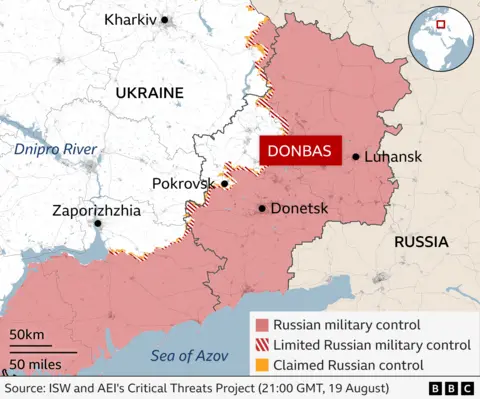
According to an estimate by Reuters news agency, Ukraine still holds about 6,600 sq km (2,548 sq miles) of territory in Donetsk.
About a quarter of a million people remain there, local officials said recently.
Major urban centres include Kramatorsk, Slovyansk, Kostyantynivka and Druzhkivka.
It forms part of Ukraine's main industrial region, the Donbas (Donets Basin), though its economy has been devastated by the war.
"The reality is these resources likely will not be able to be accessed for arguably a decade at least because of the [land] mines..." Dr Marnie Howlett, departmental lecturer in Russian and East European Politics at the University of Oxford, told Reuters.
"These lands have been completely destroyed, these cities completely flattened."
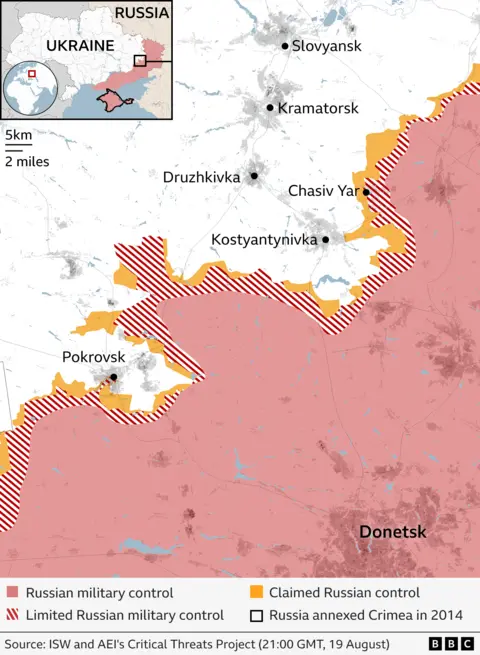
Where is the territory's military value?
A recent report by the US-based Institute for the Study of War (ISW) describes a "fortress belt" running 50km (31 miles) through western Donetsk.
"Ukraine has spent the last 11 years pouring time, money, and effort into reinforcing the fortress belt and establishing significant defense industrial and defensive infrastructure," it writes.
Reports from the region speak of trenches, bunkers, minefields, anti-tank obstacles and barbed wire.
Russian forces attacking in the direction of Pokrovsk "are engaged in an effort to seize it that would likely take several years to complete", the ISW argues.
Fortifications are certainly part of the Ukrainian defence but so is the topography.
"The terrain is fairly defensible, particularly the Chasiv Yar height which has been underpinning the Ukrainian line," Nick Reynolds, Research Fellow for Land Warfare at the UK-based Royal United Services Institute (Rusi), tells BBC News.
However, he adds: "If you look at the topography of the Donbas, eastern Ukraine in general, overall the terrain doesn't really favour the Ukrainians."
"The city of Donetsk is high ground. It's all downhill as you go west, which isn't great for the Ukrainians in terms of running defensive operations.
"That's not just about drawing in for the close fight or difficulties going up and down hill, a lot of it is also about observation and thus the ability to co-ordinate artillery fires and other forms of fire support without putting drones up.
"Likewise bits of high ground are better for radio wave propagation, better for co-ordination of drones."
Chasiv Yar, which the Russians recently claimed to have captured, "is one of the last bits of high ground the Ukrainians control", he says.
Intelligence via satellite imagery, whether provided by Ukraine's international partners or commercial, is very important, Reynolds notes, "but it is not the same as being able directly to co-ordinate one's own tactical missions".
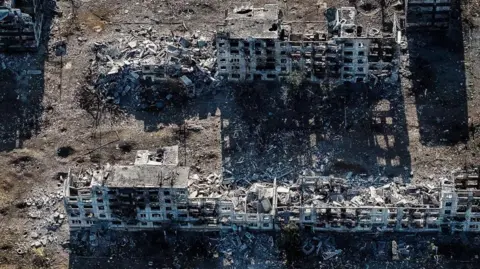
24 Mechanised brigade via EPA |Much of Chasiv Yar has been reduced to rubble
Does the Russian military need all of Donetsk?
Western Donetsk is just a small part of a front line stretching some 1,100km but it has seen some of the fiercest Russian attacks this summer.
But were Moscow to channel its ground forces in any different direction, it is doubtful whether they would make any better progress.
"In the south, the front line in Zaporizhzhia is now very similar to the one in the Donbas, so that would be just fighting through extensive defensive positions as well," says Reynolds.
"The Russians face the same problem trying to bash through in the north, so they certainly wouldn't be pushing on an open door."
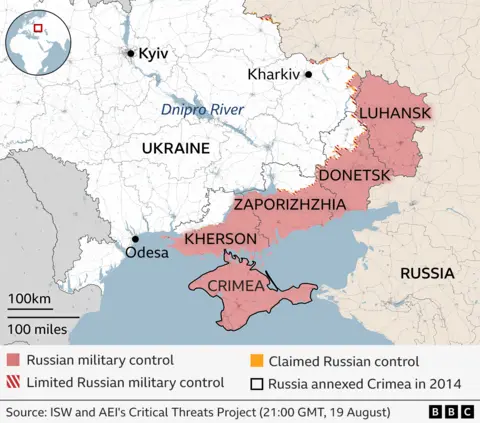
Would Ukraine be able to rebuild its defences further west?
In theory, in the event of a peace deal, the Ukrainians could move their line back further west.
There would, of course, be the issue of unfavourable terrain, and building deep defences would take time, even with the help of civilian contractors not having to work under fire.
But theory is one thing and Rusi's land warfare research fellow cannot see the Ukrainian military giving up western Donetsk without a fight.
"Even if the Trump administration tries to use ongoing US support or security guarantees as leverage," Nick Reynolds says, "based on previous Russian behaviour, based on the explicitly transactional approach that the US administration has taken, it is hard to see how the Ukrainian government would want to give up that territory."
Ukrainian President Volodymyr Zelensky has said his country will reject any Russian proposal to give up the Donbas region in exchange for a ceasefire, arguing that the eastern territory could be used as a springboard for future attacks.
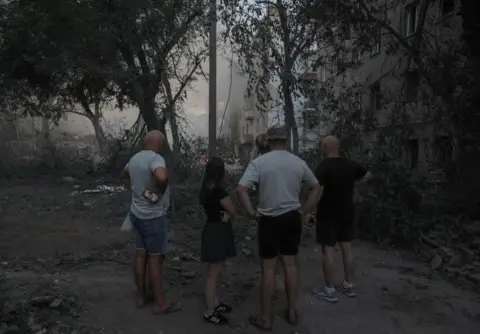
EPA/Shutterstock | Kramatorsk came under attack last month
